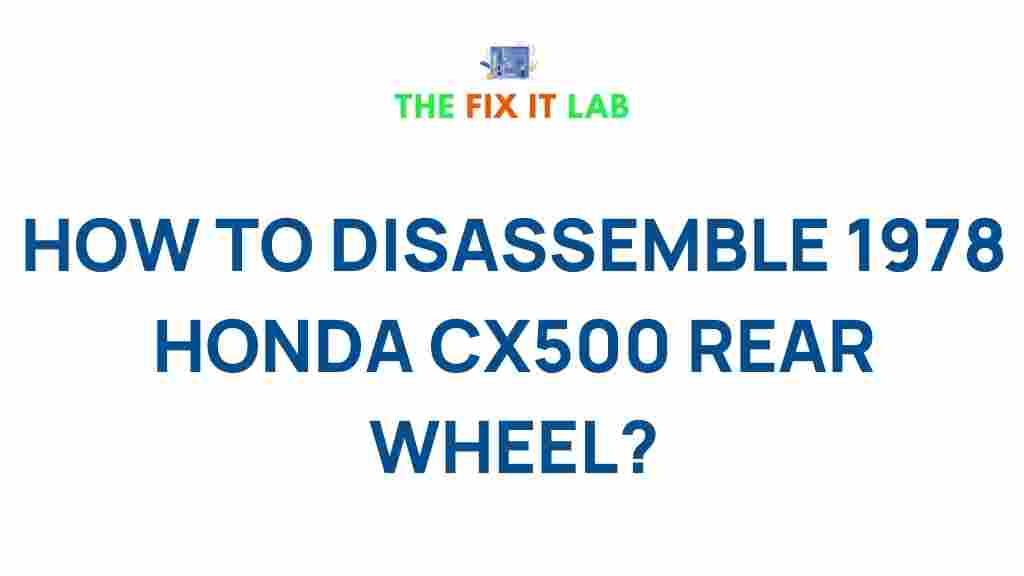The 1978 Honda CX500 is an iconic motorcycle cherished by enthusiasts for its reliability and vintage appeal. Maintaining such a classic bike requires careful attention to its components, and one essential skill for any owner is knowing how to disassemble its rear wheel. This comprehensive guide will walk you through the intriguing process of taking apart the rear wheel of this legendary machine, ensuring you can perform maintenance or replacements with confidence.
How to Disassemble a 1978 Honda CX500 Rear Wheel
Disassembling the rear wheel of a 1978 Honda CX500 may seem like a daunting task, but with the right tools, preparation, and knowledge, the process can be straightforward and rewarding. Whether you’re a seasoned mechanic or a DIY enthusiast, follow these steps to safely and efficiently remove and disassemble the rear wheel.
Tools and Materials Needed
Before you start, gather the necessary tools and materials:
- Socket wrench set
- Torque wrench
- Axle nut wrench
- Rubber mallet
- Screwdrivers (flathead and Phillips)
- Work gloves
- Shop towels
- Lubricant spray
- Replacement parts, if needed
Step-by-Step Guide to Disassemble the Rear Wheel
1. Prepare Your Workspace
Start by ensuring your workspace is clean, organized, and well-lit. Place the motorcycle on a secure stand or center stand to stabilize it during the process. This will provide the necessary clearance for wheel removal.
2. Remove the Rear Brake Assembly
The rear brake assembly must be removed first to access the rear wheel. Loosen the brake torque arm bolt using a socket wrench and detach the brake rod. Carefully set these components aside.
3. Loosen the Axle Nut
Using the appropriate axle nut wrench, loosen the rear axle nut but do not remove it completely at this stage. This will make it easier to handle the wheel later in the process.
4. Remove the Rear Wheel
Slide out the axle while supporting the rear wheel to prevent it from falling. Remove the spacers and keep them organized for reassembly. With the wheel free, gently pull it out of the swingarm.
5. Disassemble the Wheel Hub
Once the rear wheel is removed, focus on disassembling the wheel hub. Use screwdrivers to remove the retaining bolts and access the bearings. Inspect the bearings for wear or damage, replacing them if necessary.
6. Inspect and Clean
With the wheel disassembled, clean each component thoroughly using shop towels and a lubricant spray. Check for rust, cracks, or other signs of wear that may need attention. This is a good time to replace worn-out parts.
Troubleshooting Common Issues
During the disassembly process, you might encounter some challenges. Here are a few common issues and how to address them:
- Stuck axle: Apply penetrating oil and tap gently with a rubber mallet to loosen it.
- Stripped bolts: Use a bolt extractor tool to safely remove damaged bolts.
- Rusty components: Soak in a rust remover solution before attempting to disassemble.
If you’re unsure about any part of the process, consult the Honda OEM parts catalog for reference or seek professional assistance.
Reassembling the Rear Wheel
After completing maintenance or part replacement, reassemble the rear wheel by reversing the steps outlined above. Ensure all bolts are tightened to the manufacturer’s specified torque to avoid any issues during riding. Test the rear brake assembly for proper functionality before taking the bike on the road.
Why Learning to Disassemble is Important
Knowing how to disassemble and reassemble your 1978 Honda CX500 rear wheel not only enhances your mechanical skills but also extends the life of your motorcycle. Routine maintenance prevents costly repairs and ensures your bike remains in top condition for years to come.
For additional tips on maintaining your Honda CX500, check out our motorcycle maintenance guide.
Conclusion
Disassembling the rear wheel of a 1978 Honda CX500 is an essential skill for any owner or enthusiast. By following this detailed guide, you’ll gain the confidence to perform this task safely and efficiently. Regular maintenance keeps your vintage motorcycle running smoothly, allowing you to enjoy the thrill of riding a classic.
Whether you’re addressing a specific issue or simply performing routine upkeep, taking the time to disassemble and inspect your bike’s components is a worthwhile investment in its longevity.
This article is in the category Guides & Tutorials and created by TheFixitLab Team
